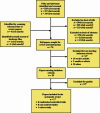The use of masks and respirators to prevent transmission of influenza: a systematic review of the scientific evidence
- PMID: 22188875
- PMCID: PMC5779801
- DOI: 10.1111/j.1750-2659.2011.00307.x
The use of masks and respirators to prevent transmission of influenza: a systematic review of the scientific evidence
Abstract
There are limited data on the use of masks and respirators to reduce transmission of influenza. A systematic review was undertaken to help inform pandemic influenza guidance in the United Kingdom. The initial review was performed in November 2009 and updated in June 2010 and January 2011. Inclusion criteria included randomised controlled trials and quasi-experimental and observational studies of humans published in English with an outcome of laboratory-confirmed or clinically-diagnosed influenza and other viral respiratory infections. There were 17 eligible studies. Six of eight randomised controlled trials found no significant differences between control and intervention groups (masks with or without hand hygiene; N95/P2 respirators). One household trial found that mask wearing coupled with hand sanitiser use reduced secondary transmission of upper respiratory infection/influenza-like illness/laboratory-confirmed influenza compared with education; hand sanitiser alone resulted in no reduction. One hospital-based trial found a lower rate of clinical respiratory illness associated with non-fit-tested N95 respirator use compared with medical masks. Eight of nine retrospective observational studies found that mask and/or respirator use was independently associated with a reduced risk of severe acute respiratory syndrome (SARS). Findings, however, may not be applicable to influenza and many studies were suboptimal. None of the studies established a conclusive relationship between mask/respirator use and protection against influenza infection. Some evidence suggests that mask use is best undertaken as part of a package of personal protection especially hand hygiene. The effectiveness of masks and respirators is likely linked to early, consistent and correct usage.
© 2011 Blackwell Publishing Ltd.
Figures

Similar articles
-
Behavioural interventions to promote workers' use of respiratory protective equipment.Cochrane Database Syst Rev. 2016 Dec 7;12(12):CD010157. doi: 10.1002/14651858.CD010157.pub2. Cochrane Database Syst Rev. 2016. PMID: 27925149 Free PMC article.
-
Individual-level interventions to reduce personal exposure to outdoor air pollution and their effects on people with long-term respiratory conditions.Cochrane Database Syst Rev. 2021 Aug 9;8(8):CD013441. doi: 10.1002/14651858.CD013441.pub2. Cochrane Database Syst Rev. 2021. PMID: 34368949 Free PMC article.
-
Protective efficient comparisons among all kinds of respirators and masks for health-care workers against respiratory viruses: A PRISMA-compliant network meta-analysis.Medicine (Baltimore). 2021 Aug 27;100(34):e27026. doi: 10.1097/MD.0000000000027026. Medicine (Baltimore). 2021. PMID: 34449478 Free PMC article.
-
Effectiveness of N95 respirators versus surgical masks in protecting health care workers from acute respiratory infection: a systematic review and meta-analysis.CMAJ. 2016 May 17;188(8):567-574. doi: 10.1503/cmaj.150835. Epub 2016 Mar 7. CMAJ. 2016. PMID: 26952529 Free PMC article.
-
Face masks to prevent transmission of influenza virus: a systematic review.Epidemiol Infect. 2010 Apr;138(4):449-56. doi: 10.1017/S0950268809991658. Epub 2010 Jan 22. Epidemiol Infect. 2010. PMID: 20092668
Cited by
-
A cluster-randomised controlled trial to test the efficacy of facemasks in preventing respiratory viral infection among Hajj pilgrims.J Epidemiol Glob Health. 2015 Jun;5(2):181-9. doi: 10.1016/j.jegh.2014.08.002. Epub 2014 Oct 2. J Epidemiol Glob Health. 2015. PMID: 25922328 Free PMC article. Clinical Trial.
-
On respiratory droplets and face masks.Phys Fluids (1994). 2020 Jun 1;32(6):063303. doi: 10.1063/5.0015044. Phys Fluids (1994). 2020. PMID: 32574231 Free PMC article.
-
Aerosolised fluorescein can quantify FFP mask faceseal leakage: a cost-effective adaptation to the existing point of care fit test.Clin Med (Lond). 2021 May;21(3):e263-e268. doi: 10.7861/clinmed.2020-0982. Clin Med (Lond). 2021. PMID: 34001582 Free PMC article.
-
Face masks could raise pollution risks.Nature. 2019 Oct;574(7776):29-30. doi: 10.1038/d41586-019-02938-1. Nature. 2019. PMID: 31576041 No abstract available.
-
Cellulose-based virus-retentive filters: a review.Rev Environ Sci Biotechnol. 2017;16(3):455-489. doi: 10.1007/s11157-017-9434-1. Epub 2017 Jun 1. Rev Environ Sci Biotechnol. 2017. PMID: 32214924 Free PMC article. Review.
References
-
- Department of Health . UK influenza pandemic preparedness strategy 2011: strategy for consultation. 22 March 2011. Available at http://www.dh.gov.uk/en/Consultations/Liveconsultations/DH_125316 (Accessed 25 March 2011).
-
- Centre for Reviews and Dissemination, University of York . CRD’s guidance for undertaking reviews in health care. 2009. Available at http://www.york.ac.uk/inst/crd/systematic_reviews_book.htm (Accessed 22 December 2009).
-
- National Health Service Critical Appraisal Skills Programme . Available at http://www.phru.nhs.uk/casp/CASP.htm (Accessed 16 November 2009).
-
- Jacobs JL, Ohde S, Takahashi O, Tokuda Y, Omata F, Fukui T. Use of surgical face masks to reduce the incidence of the common cold among health care workers in Japan: a randomized controlled trial. Am J Infect Control 2009; 37:417–419. - PubMed
-
- Loeb M, Dafoe N, Mahony J et al. Surgical mask vs N95 respirator for preventing influenza among health care workers: a randomized trial. JAMA 2009; 302:1865–1871. - PubMed
Publication types
MeSH terms
LinkOut - more resources
Full Text Sources
Medical
Miscellaneous

